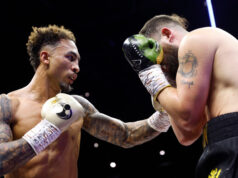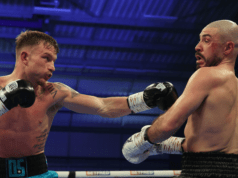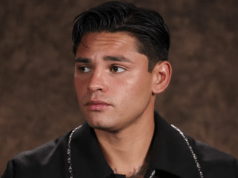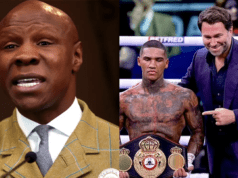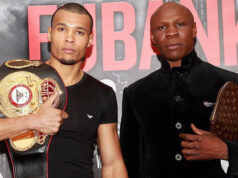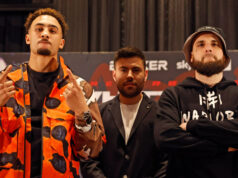How does Manny Pacquiao Stand up Against the Best Junior Welterweight Boxers in History?
By the time he arrived in the junior welterweight ranks, Manny had already begun employing some of the new techniques that now have him poised to make a serious run into the top 10 of all time. Though he was a few pounds over 140 for the De La Hoya fight, we will include that fight into our analysis alongside his emphatic knockout of Ricky Hatton.
Pacquiao showed sterling form in these two bouts, and one doesn’t necessarily need to see him blow out 6-7 more no-hopers to know he’s a handful at 140 for anyone who graced the division. Looking at Pacquiao now, one can almost still envision him as a junior welterweight. It seems his ideal weight class, free of the giants preying in the waters at 147 and above.
The junior welterweight division had its early moments, but never really took off until the 70’s. Since then, some of the greatest fighters in history have called 140 home. How would Manny Pacquiao do against these fighters?
Fight #1:
Nicolino Locche
WBA Junior Welterweight Champion (1968-1972)
117-4-14 (14 KOs)
Analysis: At one point in his reign, Locche had lost only 2 of 122 bouts. When you see that Locche had only 14 knockouts, it becomes obvious the Argentine didn’t power his way to the top. Locche depended on his defense, but what a defense it was, perhaps the flashiest of all time. You can go on You Tube and watch a balding and aging Locche against future junior welterweight star Antonio Cervantes to see his defensive mastery. Standing in the pocket, Locche allows Cervantes to tee off with his slashing punches, but Cervantes cannot lay a glove on him.
Locche had a radar-like defense and was the consummate ring general with unparalleled self-confidence. He took his opponents off their game, and then went to work offensively once he had them off stride. Against Pacquiao, it would work to some degree. Manny has never in his career faced this kind of opponent, which is understandable. It’s one thing to batter willing participants like David Diaz and Ricky Hatton, but what happens when a guy refuses to cooperate?
Manny would get frustrated early, as Locche’s radar would keep him out of immediate danger. But Manny is no one-trick pony. He can adapt too. Manny could surpass the fury and talent of any of Locche’s title challengers, therefore rendering Locche’s jive tactics a little moot after a certain point in the fight. In a fight that mentally exhausts Pacquiao, he manages to nose ahead in the second half of the fight, but Locche was so slippery and hard to hit that he could probably guile his way to the final bell.
Result: Manny Pacquiao by unanimous decision.
Fight #2:
Aaron Pryor
WBA/ IBF Junior Welterweight Champion (1980-1985)
39-1 (35 KOs)
Analysis: Aaron Pryor was the total package. A ball of fury and hunger wrapped up in a skillful package. His will, durability, passion, and confidence were unmatched. His only loss came long after falling victim to the glass pipe. It is during his prime where he made history: a long undefeated run punctuated by brutal knockouts over hall of famers Antonio Cervantes and Alexis Arguello.
This would be a fight fan’s delight. Fight fans pan for gold hoping to find nuggets like this from time to time. It’s a shame it can only exist in fantasyland, for this would be one for the ages. You have two offensive whirlwinds with their self-belief bursting at the seams.
A prime Pryor was a man who simply refused to acknowledge what the opponent did to him. When hurt, he would just get angry and redouble his efforts. His chin was concrete, but his will is what really allowed him to take flush shots from hall of fame fighters without faltering. Sometimes a great chin is more of an anatomic anomaly and other times it stems from an unshakeable sense of self-belief. Pryor’s durability may fall more into the latter category. Would it be enough to see him through the storm of leather Pacquiao would bring to this matchup?
To some degree, I believe it would. While Arguello may have hit harder with a single shot, Manny would bring more punch variety and angles into this fight. I see Pryor in the role of pursuer, though not really the puncher in the fight. Who’s to say Aaron doesn’t walk into a killer Pacquiao hook like Hatton did? Well, Pryor was a lot better than Hatton. His M.O. was basically to throw punches as fast and hard as he could for as long as he could. And it was always good enough.
Manny had developed a new wrinkle by this point in his career that might change the complexion of the fight. It’s as if he suddenly became a very advanced study in the art of ring geometry. You rarely see Manny in a vulnerable spot nowadays. He works the angles masterfully, always in a position to do damage while not overly-exposing himself in the wheelhouse of his opponent.
Whether he could do this against Pryor is problematic. Pryor was so frenetic in his attack that an opponent wouldn’t be allowed to set up shop from the outside for too long. Manny would be forced to fight, and I think this fight would gradually become waged more on the inside as the fight progressed. At the end of the day, it would come down to Pryor’s fury and volume against Manny’s speed and athleticism.
The first half of the fight would find Manny finding success picking off Pryor from the outside with his flashier shots. Pryor would pick up steam and Manny would have to call on all his talent and desire to avoid succumbing to the storm. The fight would come down to the wire, with the hard-charging Pryor gaining momentum in the later rounds.
The feeling here, not made with total conviction, is that Manny would barely be able to hold off Pryor to eke out a split decision win. I think the difference could be whether the bout was scheduled for 12 or 15 rounds.
Result: Manny Pacquiao by split decision.
Fight #3:
Julio Cesar Chavez
WBC Super Lightweight Champion (1989-1994, 1994-1996)
107-6-2 (86 KOs)
Analysis: Chavez was unbeaten in his first 90 fights. At his peak, he was the best in the sport. Watching him fight, you may not be immediately awestruck. Such was the case with Chavez—not great in any obvious, eye-catching manner, but yet an unstoppable force. He was like the tide. You knew what was coming and there was no way to stop it. This viewer has yet to see another fighter with the ability to block out what the other guy was doing better the “Lion of Culiacan.”
While his opponents were sometimes more flashy, harder punching, and slicker, none of them were able to beat Chavez until he was well past his prime. He moved forward, seldom over-extended himself, and worked the body with a gusto rarely seen before or since. Fans and opponents alike were often surprised when in the later rounds; Chavez would have his man beaten to smithereens. It would be so gradual and workmanlike that you would miss it if you didn’t pay close attention.
The Meldrick Taylor fight is a microcosm to Chavez’ brilliance. Most viewers saw the lightning-quick Taylor dominating the fight with his rapid-fire combinations. By the later rounds, Taylor began to look like a man beaten with a baseball bat. Viewers were left asking, “Whoa, what happened to Meldrick?” After the controversial finish, we discovered the true brutality of Chavez’ attack. Taylor suffered fractures to his facial bones, swallowed a ton of blood, and had damage to his kidneys and liver. He would never be the same.
Chavez could operate with the knowledge and confidence that what his opponent did was irrelevant. It was all about whether his opponent could withstand what Chavez brought to the table. For many years, it was enough to make him the best in the sport. Speed troubled Julio, but he still managed to brutalize both Taylor and Camacho, two of the fastest fighters of all time.
Against Manny, Julio would have his hands fuller than he did with Taylor or Camacho. Manny has terrific speed, but extra elements that could additionally trouble Chavez. Manny’s power would make Chavez somewhat more respectful. His use of angles and movement would be enough to give Julio a terribly difficult evening. I think it is fair to say both men would be facing their all-time toughest opponent in this matchup.
However, a prime Chavez was an irresistible force. Manny would win a bunch of early rounds, but in doing so, would also take a horrific battering to the body. Julio would be cognizant of the fact that he could not battle Manny on even terms swapping head shots early, so he would devote himself to a body attack. By the middle rounds, Manny would begin to feel the affects. He would soon be unable to attack with the flair of earlier rounds, increasingly falling into Julio’s range. Whereas Manny may have been able to gut his way through a Pryor fight, the Chavez attack has a greater truth to it.
If Manny could get to the scorecards, he would have a chance based on all the early rounds he put in the bag, but Julio’s constant aggression and late-rounds surge would make a stronger case. The fight would be competitive enough to warrant a rematch and perhaps a rubber match. But I see Julio getting a late knockdown to win a close one.
Result: Julio Cesar Chavez by unanimous decision.
Fight #4
Kostya Tszyu
IBF/WBC/Unified Junior Welterweight Champion (1995-1997, 1998-2005)
31-2 (25 KOs)
Analysis: Don’t laugh it off. Boxing is based on styles. Tszyu just might have the right mix of skills to trouble the historically more significant figure in Manny Pacquiao. Kostya was very adept at timing faster fighters with fight-ending shots. The Zab Judah fight stands out as a good example, and even though Judah has subsequently shown his chin to be at least a notch below granite, the fight showed Kostya’s ability to combat speed with aplomb.
This fight strikes me as almost the best of the bunch. It would be a knockdown, drag-out brawl that would have the MGM crowd crackling in a frenzied state. Kostya would start strongly, scoring a flash knockdown in the first round. A more serious knockdown in the second would have Pacquiao backers in a worrisome state.
Manny would gain his footing in the 4th and 5th rounds before exploding with a combination in the 6th round sending Tszyu splattering to the canvas. While moving in for the finish, Tszyu would once again perfectly time Manny with a right hand sending Manny down for a third time. The bell would sound, with Manny needing to hold onto the ropes to navigate his way back to his corner.
Implored by trainer Freddie Roach to rely on movement and speed, Manny would edge round 8. In the 9th round, Manny would begin to click on a spent Tszyu, timing his rushes with crisp fusillades of telling shots. Manny would zero in with a few power shots, and the referee would have to jump in to save a badly hurt Tszyu.
This fight would show Manny as a fighter who can overcome severe adversity, a prerequisite trait of a fighter hoping to one day be in the very top pantheon of all-time greats.
Result: Manny Pacquiao by ninth-round TKO.
Stay tuned to see how Pacquiao does against the best welterweights of all time. Of course, that piece of the series will have even more relevance should the Pacquiao vs. Mayweather fight gets finalized. However, by fighting Oscar De La Hoya and Miguel Cotto in the division, even without Manny Pacquiao fighting Floyd Mayweather it’s worth taking a look at.


